Your Complete Guide to TV Unit Sizes (With Recommendations)
Need help choosing the right TV unit size to fit your room and television? Our guide breaks down how to find the best size unit for your screen, as well as how to make sure it doesn’t detract from the beauty of your living room.
There are a couple of factors that’ll influence which TV unit you should choose.
The size and weight of the TV are one element, as is the space you have in your room and the overall aesthetic of your home. So, it’s really about weighing up the practical and design aspects to ensure you’re making the right choice.
No matter if you've just bought yourself a brand-new TV and need a new unit to put it on, or you're overhauling your living room layout and need an updated stand that matches the rest of your furniture, our guide can help you out and provide some brilliant recommendations along the way.
General TV Unit Size Chart
We’ve put together a table with our recommendations of what TV unit sizes are best depending on your TV screen dimensions.
Please bear in mind that things like the weight of the TV and the space in your living room will also affect which unit you choose, but these are a great guide to get started.
| TV Size (Inches) | Unit Width |
|---|---|
| 32? | 27.9 in / 70.9 cm |
| 37? | 32.2 in / 81.8 cm |
| 42? | 36.6 in / 93 cm |
| 46? | 40.1 in / 101.9 cm |
| 50? | 43.6 in / 110.7 cm |
| 55? | 47.9 in / 121.7 cm |
| 60? | 52.3 in / 132.8 cm |
| 65? | 56.7 in / 136.4 cm |
| 70? | 61.1 in / 155.2 cm |
| 75? | 65.4 in / 166.1 cm |
How to Find Your Ideal TV Unit Size
Finding the correct size of stand for your TV is important to keep your living room looking balanced. You don’t want a clunky or chunky piece of furniture ruining the sleek look of your new TV.
Not only that, but it’s important for safety, too. A stand that's too small, narrow, or flimsy can lead to your TV toppling over and potentially causing damage or injury.
Our chart above provides some approximate size recommendations, but we do suggest taking into consideration the points below before making your choice.
So, with that in mind, here's how to find the perfect size TV unit for your living room…
1. Measure the Full Size of Your TV
While the screen size of your TV is often the most advertised measurement, it's essential to measure the full size of your TV to ensure it fits your chosen TV unit.
The screen size typically refers to the diagonal length of the display, excluding the frame or bezel, which can vary significantly between models.
By measuring the full dimensions, you can account for the width, height, and depth of the television, ensuring a proper fit and avoiding potential compatibility issues.
To get the full dimensions...
- Start by measuring the width of your TV. Use a tape measure to measure horizontally from one edge of the frame to the other at the widest point.
- Next, measure the height by running the tape measure from the bottom to the top of the frame, including the stand if it is permanently attached.
- Finally, measure the depth by checking how far the back of the TV protrudes to the front, including any stand or mount attachments.
2. Choose the Right Unit Width
Once you have your TV measurements, you can begin selecting the right size TV stand. TV stands are typically measured horizontally, so it’s important to check the width of the unit carefully.
For the best fit, choose a TV stand that’s a few inches wider than your television.
A general guideline is to ensure there’s about 3 inches of space from the edge of your TV to the edge of the stand on each side.
This not only creates a balanced appearance but also provides extra stability to avoid tip-over accidents and prevents your TV from looking cramped.
3. Consider the Height of Your TV Stand
The height of the TV stand is just as important as the width when it comes to creating a comfortable viewing experience.
A simple formula to determine the ideal TV stand height is to measure the distance from the floor to your eye level while seated, then subtract half the height of your TV.
A TV positioned too high or low can strain your neck and impact your posture over time. It’s best to have the centre of the TV screen at or just below eye level when you’re seated on the sofa.
This helps to create an ergonomic setup that promotes both a relaxing and healthy viewing environment.
Learn more about how to position your TV in our guide below.
4. Selecting the Best Unit Depth
The depth of the unit refers to how far away from the wall it protrudes (assuming you’ll have the unit flush against a wall). This is an important factor to consider when choosing a TV stand, especially if you have limited space in your living room.
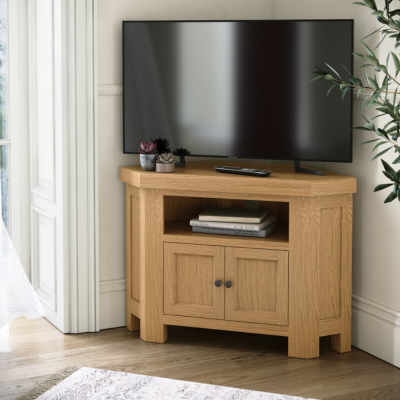
With modern TVs generally being as flat as possible, the depth of the TV stand is less of a concern than it used to be in terms of whether your screen will fit, but it’s still important in regards to the rest of your room.
Ultimately, the TV stand should be deep enough to comfortably accommodate the feet of your TV. We’d recommend having a few extra inches front and back for added security.
You also need to take into account the other devices your unit might hold. For example, if you have streaming boxes, games consoles, speakers, or routers by your TV, these will also need to fit.
5. Account for the Weight of Your TV
The size of the TV is of course important in this situation, but the weight is also a crucial factor to consider when choosing the right TV stand.
Most TV stands are built to comfortably withstand the weight of modern TVs (after all, they’re much lighter than they used to be!), but if your TV is particularly large, it’s worth thinking about a bit more deeply.
In general, we recommend opting for units made from solid wood, particularly if you have a bigger screen. Solid wood provides a sturdy and strong base for your TV, ensuring it remains stable and secure while in use.
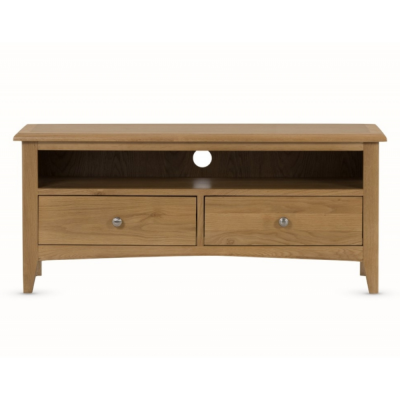
For example, our Baden Large TV Unit is made from solid oak and can easily support large TVs. Our Leandro Large TV Cabinet, on the other hand, is made from Lamulux, which is strong but doesn’t have the same lifespan as solid wood, so it might be best for lighter screens.
The majority of our TV units are made from solid oak with veneers for aesthetic appeal, so you get a sturdy piece of furniture that still looks beautiful.
What Size TV Fits on a Corner TV Stand?
When selecting a TV for a corner TV stand, it's essential to consider both the size of the TV screen and the available surface area.
Typically, a corner stand measures between 100cm and 110cm and is well-suited for TVs with screens ranging from 40 inches to 50 inches.
For instance, a 40-inch TV typically has a width of around 90cm, leaving sufficient room on a 100cm to 110cm stand to accommodate extra decorative items or cable management.
For a 50-inch TV, which usually has a width of approximately 112cm, it would slightly overhang on the narrower end of this stand range unless the stand has additional depth or supports.
It’s also worth considering the design of the stand—some have angled edges or additional shelving that can impact the usable width for your TV.
Always ensure the weight and dimensions of your TV are compatible with the specific corner unit you choose for stability and aesthetics.
Do You Need a TV Unit for a Wall-Mounted TV?
While a wall-mounted TV doesn’t necessarily require a TV unit, having one can still be highly beneficial. A TV unit offers storage space for devices such as gaming consoles, streaming boxes, and soundbars, as well as helping to hide unsightly cables for a tidier appearance.
A well-designed TV unit can also serve as a focal point in the room, complementing the aesthetics while providing practical functionality.
If the TV is mounted high up, a unit below it can balance the visual proportions of the space.
Ultimately, whether you need one depends on both your storage needs and the overall design of your living area.
How to Match Your TV Stand to Your Interior Design
Matching your TV stand to your aesthetic can help create a cohesive and purposeful aesthetic in your living room.
When the finishes are the same or complement each other, the space often feels more organised and intentional, contributing to a polished, harmonious look.
We have a wide range of TV units that fit a variety of interior styles, so you don’t have to overhaul your furniture for your new stand.
.png)
For contemporary living rooms, the clean aesthetics of the Leandro Small TV Cabinet are perfect. It even has rounded, child-friendly corners and is highly scratch-resistant to keep the modern look effortlessly.
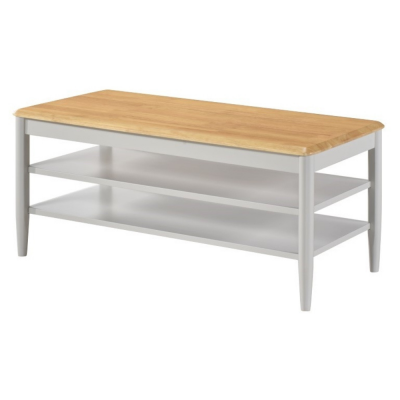
If you have a minimalist style in your living room, the Fowey TV Unit is an ideal choice. The solid hardwood top, stone grey legs, and clean lines are ideal for simple but functional spaces.
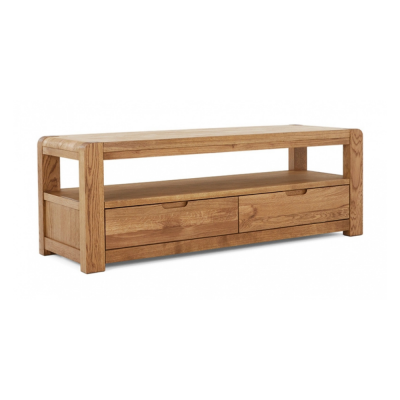
Of course, natural wood finishes are classic for TV units, and the Baden Large TV Unit is an ideal choice if that’s your preferred aesthetic. The inset handles keep this unit looking modern, while the natural solid oak finish provides a classic, timeless look.
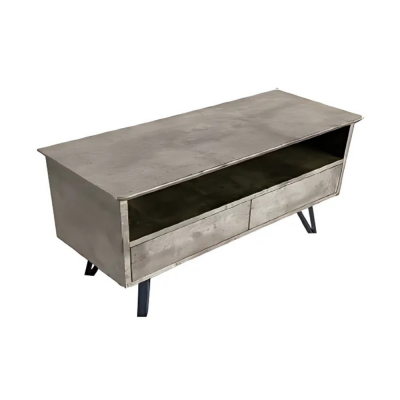
For more industrial interiors, the Toledo TV Cabinet is the ultimate choice with a concrete effect finish and powder-coated steel legs for a more modern and harsh look.
Can You Use a Console Table as a TV Stand?
Using a console table as a TV stand is generally not recommended.
Console tables are often not designed to support the size or weight of most modern televisions, which can exceed the table's weight limit.
Placing a heavy TV on a console table could lead to the table sagging, cracking, or even collapsing, potentially damaging both the table and your TV.
Console tables are usually narrower than purpose-built TV stands, increasing the risk of the TV overhanging or becoming unstable.
For safety and durability, it's always best to invest in a specially designed TV unit. They offer the proper support and dimensions to accommodate your television, ensuring a secure and stylish setup.
Can You Use a Coffee Table as a TV Unit?
While coffee tables are typically sturdier than console tables, they are still not ideal for use as a TV unit.
One common issue is their height—coffee tables are often much lower than purpose-built TV units, which can lead to an uncomfortable viewing angle, especially during extended periods of watching.
Also, repurposing a coffee table as a TV stand reduces its functionality in its intended role, leaving you with less surface space for placing drinks, books, or decorative items.
For a practical and comfortable setup, it’s advisable to choose a TV unit designed specifically for the purpose.
Find Your Perfect TV Unit With Fairway Furniture
At Fairway Furniture, we offer a wide range of TV units designed to suit any living room decor. With various sizes, styles, and finishes available, you can find the perfect unit to complement your space while safely displaying your TV.
Whether you’re looking for a contemporary design or a classic look, our collection provides practical storage solutions and exceptional aesthetic appeal to enhance your living area.
Shop our full range of TV stands online or visit us in-store.
FAQS






